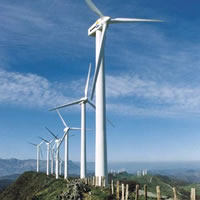Wind farms can generate much power but threaten birds and bats
Wind farms could generate as much as 7 percent of U.S. electricity in 15 years, but scientists want to study the threat those spinning blades pose to birds and bats.

The towers appear most dangerous to night-migrating songbirds, bats and some hunting birds. The risk is not well enough known to draw conclusions, a panel of the National Research Council said Thursday in a study requested by Congress.
Wind has powered sailing ships for thousands of years and has long been important to turn windmills that move water and grind grain. Only in recent years had the potential of the wind to generate electricity been tapped.
Wind farms generate electricity by using the wind to turn giant blades that rotate turbines to make power. The blades have diameters ranging from 70 meters to 90 meters (230 feet to 295 feet) and are mounted on towers between 60 meters and 90 meters (197 feet and 295 feet) tall. Some farms contain hundreds of towers. The one at Altamont Pass, California, has more than 5,000.
Growing from almost nothing in 1980, wind powered turbines generated 11,605 megawatts of electricity in the United States in 2006, though that was still less than 1 percent of the national power supply.
Wind farms now operate in 36 states. The report says estimates are that this source could generate from 2 percent to 7 percent of the nation's electricity within 15 years.
By reducing the need to generate electricity from by burning fossil fuels the turbines have been welcomed as a boon to the environment. Others worry about the danger to birds and bats, impacts on wildlife habitat and what some see as a blight on the scenery.
Overall, the report noted, the benefits of wind-energy development such as reductions in air pollutants benefit wide areas, while the environmental costs, such as effects on the ecology and increased mortality of birds and bats, occur locally.
The Research Council, as arm of the National Academy of Sciences, concluded that:
By the year 2020 wind generators could offset as much as 4.5 percent of emissions of the greenhouse gas carbon dioxide from electricity production. The savings would be less in the mid-Atlantic states where there is less regular wind.
Wind generation in the mid-Atlantic highlands elevated regions of Virginia, West Virginia, Maryland and Pennsylvania is unlikely to reduce emissions of nitrous oxide and sulfur dioxide because current and upcoming regulation will limit those emissions in eastern states.
In the mid-Atlantic highlands, preliminary studies indicate that more bats are killed than expected based on experience with bats in other regions. There is not enough information to determine whether the number of bats killed will have overall effects on populations. However, there has been a region-wide decline in several species of bats in the eastern states, so the possibility of population effects is significant.
Turbines placed on ridges, as many are in the mid-Atlantic highlands, appear to have a higher probability of causing bat fatalities than those at many other sites
At current levels of use, there is no evidence that fatalities caused by wind turbines result in measurable demographic changes to bird populations nationwide, with the possible exception of raptor fatalities in the Altamont Pass area. However, data are lacking for a many facilities.
While aesthetic concerns often are the most heard about proposed wind-energy projects, few decision processes adequately address them.
Other potential human impacts include effects on cultural resources such as historic, sacred, archaeological and recreation sites and the potential for electromagnetic interference with television and radio broadcasting, cellular phones and radar.
The National Academy is an independent organization chartered by Congress to advise the government on scientific matters.
Subscribe to Pravda.Ru Telegram channel, Facebook, RSS!


